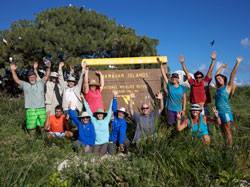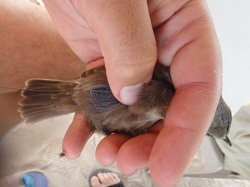
Second Translocation of Millerbirds Completed
A team working on a joint effort to save one of the United States' rarest bird species from extinction returned from a successful expedition to Papahānaumokuākea Marine National Monument last week. Taking advantage of mild summer sea conditions in the Northwestern Hawaiian Islands, the team of biologists from the U.S. Fish and Wildlife Service (FWS), American Bird Conservancy (ABC), and other organizations captured 26 Millerbirds on Nihoa Island and transported them to Laysan Island, 650 miles further northwest in the chain of islands, where they were released.
This second translocation took place between August 12 and August 18, and was part of a multi-year effort to restore Millerbirds to Laysan Island within the Hawaiian Islands National Wildlife Refuge and Papahānaumokuākea Marine National Monument and World Heritage site.

Team members moving captured Millerbirds down the steep, rocky shorline of Nihoa Island. Credit: R. Hagerty/USFWS
Millerbirds have been absent from Laysan for almost a century as a result of habitat destruction due to introduced rabbits and other livestock. FWS has been working to restore Laysan's native vegetation for more than two decades. A self-sustaining Millerbird population on Laysan will ensure that the species is no longer vulnerable to extinction from a catastrophic event on Nihoa such as a hurricane or the accidental introduction of an alien predator or disease.
Last year, in the highly successful first phase of the translocation effort, 24 Millerbirds were moved from Nihoa to Laysan. Since their September 10, 2011, release this pioneer group of birds has survived and thrived, producing 17 young. With the 26 Millerbirds brought to Laysan last week, the target goal of translocating 50 "founder" Millerbirds has been met.
During the voyage from Nihoa to Laysan aboard the M/V Searcher, the Millerbirds were cared for by avian husbandry experts and a wildlife veterinarian from the U.S. Geological Survey. The team spent several days on Nihoa capturing the birds and allow them to acclimate to captivity prior to the three-day voyage to Laysan, and another three days on Laysan releasing the birds and to initiate radio-tracking of their movements.
A Native Hawaiian cultural liaison accompanied the biologists on the voyage and remained on Nihoa with the biological monitoring team. Two biologists will remain on Laysan through the end of October, and one will remain through the winter to monitor the newly released Millerbirds, the young produced in 2012, and the adults translocated in 2011.
The Millerbird, which weighs less than an ounce, is a lively gray and brown bird that forages for insects among low shrubs and bunch-grasses. On Laysan, it joins the Laysan Finch, Laysan Duck, Hawaiian monk seal, several endangered plant species, and millions of nesting seabirds.
Close observation of the first group of translocated Millerbirds over the past 11 months has yielded significant new scientific information about the species, such as details of breeding chronology, the fact that pairs can produce more than one brood in a season, and a still-emerging picture of how young birds mature and enter the breeding population. All this information is important in assessing the progress toward population establishment on Laysan and is valuable in the conservation and management of the species. The success to date indicates that Laysan has suitable habitat and adequate food resources to support Millerbirds.

Team members on Laysan. (standing from Left to right) Peter Luscomb, Chris Farmer, Thierry Work, Michele Kuter, Claudia Mischler, Tawn Speetjens and Amy Munes. (kneeling/ left to right) Robby Kohley, Dr. Sheila Conant, Sheldon Plentovich, Michelle Wilcox, John Vetter and Toni Caldwell. Credit: S. Plentovich/USFWS
As a co-manager of the Papahānaumokuākea Marine National Monument and World Heritage Site, the FWS is proudly led this project in collaboration with American Bird Conservancy, and are grateful for the support and assistance from the National Fish and Wildlife Foundation, the University of New Brunswick, University of Hawaiʻi, the U.S. Geological Survey National Wildlife Health Research Center, and the Office of Hawaiian Affairs.
To learn more about the Millerbird project and read updates from Laysan, visit www.fws.gov/pacificislands/.
To view pictures from the latest translocation, visit: http://www.flickr.com/photos/usfwspacific/sets/72157631324144040/ (you will be directed to a non-NOAA website).
To view the Press Release, click here.


